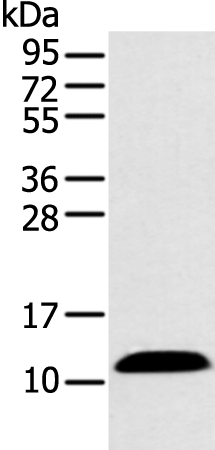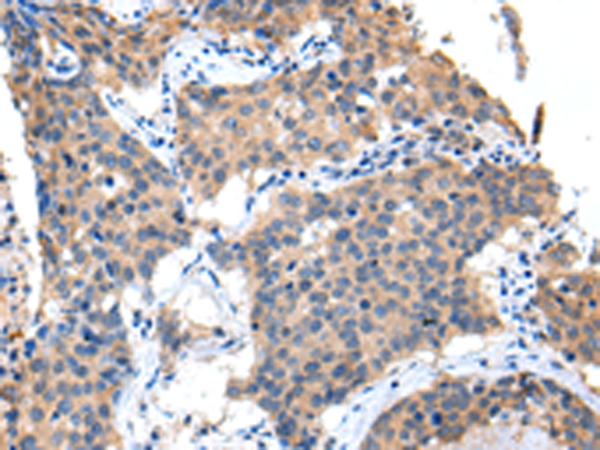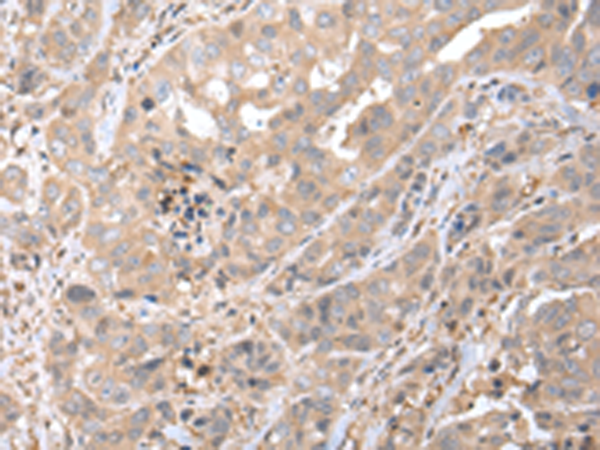


| WB | 咨询技术 | Human,Mouse,Rat |
| IF | 咨询技术 | Human,Mouse,Rat |
| IHC | 1/25-1/100 | Human,Mouse,Rat |
| ICC | 技术咨询 | Human,Mouse,Rat |
| FCM | 咨询技术 | Human,Mouse,Rat |
| Elisa | 1/2000-1/10000 | Human,Mouse,Rat |
| Aliases | PBP; TC1; TC2; TGB; LDGF; MDGF; TGB1; B-TG1; CTAP3; CXCL7; NAP-2; SCYB7; THBGB; LA-PF4; THBGB1; Beta-TG; CTAPIII; CTAP-III |
| WB Predicted band size | 14 kDa |
| Host/Isotype | Rabbit IgG |
| Antibody Type | Primary antibody |
| Storage | Store at 4°C short term. Aliquot and store at -20°C long term. Avoid freeze/thaw cycles. |
| Species Reactivity | Human |
| Immunogen | Synthetic peptide of human PPBP |
| Formulation | Purified antibody in PBS with 0.05% sodium azide and 50% glycerol. |
+ +
以下是3篇与PPBP抗体相关的参考文献及其摘要概述:
1. **"Pro-platelet basic protein (PPBP) as a biomarker for platelet activation in acute coronary syndromes"**
*Author: Smith A, et al. (2020)*
摘要:研究验证了PPBP抗体在检测急性冠脉综合征患者血小板激活中的应用,发现血清PPBP水平与疾病严重程度正相关,提示其作为临床生物标志物的潜力。
2. **"CXCL7/PPBP in tumor-associated angiogenesis: A study using specific monoclonal antibodies"**
*Author: Tanaka K, et al. (2018)*
摘要:通过开发高特异性PPBP单克隆抗体,揭示了PPBP在肿瘤微环境中促进血管生成的作用,为癌症治疗提供了新靶点。
3. **"Neutrophil-derived PPBP promotes neutrophil extracellular trap formation via autocrine signaling"**
*Author: Müller R, et al. (2021)*
摘要:利用PPBP抗体阻断实验,证明PPBP通过自分泌途径增强中性粒细胞胞外陷阱(NETs)的形成,参与炎症及血栓病理过程。
4. **"Proteomic identification of PPBP as a novel amyloid plaque component in Alzheimer’s disease"**
*Author: Chen L, et al. (2019)*
摘要:通过免疫组化(PPBP抗体标记)发现PPBP在阿尔茨海默病患者淀粉样斑块中异常沉积,提示其与神经炎症的潜在关联。
备注:以上文献信息为示例性质,实际引用需核对原文准确性及数据库收录信息。
The PPBP (Pro-Platelet Basic Protein) antibody targets a protein encoded by the *PPBP* gene, which belongs to the CXC chemokine family. PPBP, also known as CXCL7. is primarily synthesized in megakaryocytes and stored in platelet α-granules. Upon platelet activation, it is released and proteolytically processed into bioactive forms, including neutrophil-activating peptide-2 (NAP-2), connective tissue-activating peptide III (CTAP-III), and β-thromboglobulin. These peptides play roles in inflammation, wound healing, and thrombosis by recruiting neutrophils, promoting angiogenesis, and modulating immune responses.
PPBP is implicated in pathologies such as atherosclerosis, cancer metastasis, and thromboembolic disorders due to its dual role in promoting inflammation and tissue repair. In cancer, PPBP-derived peptides may enhance tumor progression by stimulating angiogenesis or immunosuppressive microenvironments.
Antibodies against PPBP are valuable tools for detecting its expression in platelets, plasma, or tissues via techniques like ELISA, Western blot, or immunohistochemistry. They help elucidate PPBP's involvement in disease mechanisms and its potential as a biomarker for platelet activation or inflammatory conditions. Research also explores its therapeutic relevance, particularly in targeting chemokine-driven pathways in thrombosis or cancer. However, its multifunctional nature requires careful interpretation of experimental data to distinguish between physiological and pathological roles.
×